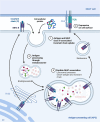The multifaceted roles of cathepsins in immune and inflammatory responses: implications for cancer therapy, autoimmune diseases, and infectious diseases
- PMID: 39736788
- PMCID: PMC11687005
- DOI: 10.1186/s40364-024-00711-9
The multifaceted roles of cathepsins in immune and inflammatory responses: implications for cancer therapy, autoimmune diseases, and infectious diseases
Abstract
The cathepsin family comprises lysosomal proteases that play essential roles in various physiological processes, including protein degradation, antigen presentation, apoptosis, and tissue remodeling. Dysregulation of cathepsin activity has been linked to a variety of pathological conditions, such as cancer, autoimmune diseases, and neurodegenerative disorders. Understanding the functions of cathepsins is crucial for gaining insights into their roles in both health and disease, as well as for developing targeted therapeutic approaches. Emerging research underscores the significant involvement of cathepsins in immune cells, particularly T cells, macrophages, dendritic cells, and neutrophils, as well as their contribution to immune-related diseases. In this review, we systematically examine the impact of cathepsins on the immune system and their mechanistic roles in cancer, infectious diseases, autoimmune and neurodegenerative disorders, with the goal of identifying novel therapeutic strategies for these conditions.
Keywords: Autoimmune diseases; Cancer therapy; Cathepsins in immune cells; Infectious diseases.
© 2024. The Author(s).
Conflict of interest statement
Declarations. Ethics approval and consent to participate: Not applicable. Consent for publication: Not applicable. Competing interests: The authors declare no competing interests.
Figures



Similar articles
-
The Key Role of Lysosomal Protease Cathepsins in Viral Infections.Int J Mol Sci. 2022 Aug 13;23(16):9089. doi: 10.3390/ijms23169089. Int J Mol Sci. 2022. PMID: 36012353 Free PMC article. Review.
-
Unveiling the Roles of Cysteine Proteinases F and W: From Structure to Pathological Implications and Therapeutic Targets.Cells. 2024 May 25;13(11):917. doi: 10.3390/cells13110917. Cells. 2024. PMID: 38891048 Free PMC article. Review.
-
Cysteine Cathepsins as Therapeutic Targets in Immune Regulation and Immune Disorders.Biomedicines. 2023 Feb 7;11(2):476. doi: 10.3390/biomedicines11020476. Biomedicines. 2023. PMID: 36831012 Free PMC article. Review.
-
Insights into the roles of cathepsins in antigen processing and presentation revealed by specific inhibitors.Biol Chem. 2003 Jun;384(6):883-90. doi: 10.1515/BC.2003.099. Biol Chem. 2003. PMID: 12887055 Review.
-
Cysteine cathepsins: From diagnosis to targeted therapy of cancer.Biochimie. 2024 Nov;226:10-28. doi: 10.1016/j.biochi.2024.09.001. Epub 2024 Sep 6. Biochimie. 2024. PMID: 39245316 Review.
Cited by
-
Multi-Omics Unveils Inflammatory Regulation of Fermented Sini Decoction Dregs in Broilers Infected with Avian Pathogenic Escherichia coli.Vet Sci. 2025 May 15;12(5):479. doi: 10.3390/vetsci12050479. Vet Sci. 2025. PMID: 40431572 Free PMC article.
-
Identification, Expression Profiling, Microbial Binding, and Agglutination Analyses of Two Cathepsin B Genes in Black Rockfish (Sebastes schlegelii).Mar Drugs. 2025 May 18;23(5):213. doi: 10.3390/md23050213. Mar Drugs. 2025. PMID: 40422803 Free PMC article.
-
Cathepsin B Levels Correlate with the Severity of Canine Myositis.Biomolecules. 2025 May 21;15(5):743. doi: 10.3390/biom15050743. Biomolecules. 2025. PMID: 40427636 Free PMC article.
-
Stimuli-Responsive Nanomedicines for the Treatment of Non-cancer Related Inflammatory Diseases.ACS Nano. 2025 Apr 29;19(16):15189-15219. doi: 10.1021/acsnano.5c00700. Epub 2025 Apr 18. ACS Nano. 2025. PMID: 40249331 Free PMC article. Review.
References
-
- Olson OC, Joyce JA. Cysteine cathepsin proteases: regulators of cancer progression and therapeutic response. Nat Rev Cancer. 2015;15(12):712–29. - PubMed
-
- Vizovišek M, Fonović M, Turk B. Cysteine cathepsins in extracellular matrix remodeling: extracellular matrix degradation and beyond. Matrix Biology: J Int Soc Matrix Biology. 2019;75–76:141–59. - PubMed
-
- Fonović M, Turk B. Cysteine cathepsins and extracellular matrix degradation. Biochim Biophys Acta. 2014;1840(8):2560–70. - PubMed
Publication types
Grants and funding
LinkOut - more resources
Full Text Sources

